Top 5 articles regarding robots in 2011
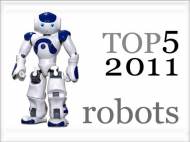 As the proof of our last year statement that robots are being developed to aid humans in their daily habits, the most popular articles in the last year were nearly all about robots which interact with humans or help us in our everyday lives. There were also many examples of robots whose operation or design were inspired by nature, as well as an article how robots could be used in architecture.
As the proof of our last year statement that robots are being developed to aid humans in their daily habits, the most popular articles in the last year were nearly all about robots which interact with humans or help us in our everyday lives. There were also many examples of robots whose operation or design were inspired by nature, as well as an article how robots could be used in architecture.
Here are the 5 most popular articles regarding robots in 2011:
5. DONA – a donation gathering robot
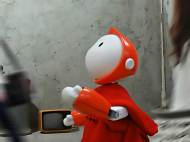 In order to counter the relatively low rate of donations made by individuals in South Korea, designer Min Su Kim created DONA – a charming little robot designed to gather donations for various charitable causes across the world. Although the robot has 20 predefined gestures, in its demonstration it is programmed to perform only a couple of its animations in order to ask for donations, thank or bow to people when they are within its range.
In order to counter the relatively low rate of donations made by individuals in South Korea, designer Min Su Kim created DONA – a charming little robot designed to gather donations for various charitable causes across the world. Although the robot has 20 predefined gestures, in its demonstration it is programmed to perform only a couple of its animations in order to ask for donations, thank or bow to people when they are within its range.
In order to provide emotional feedback in response to people’s donation, the robot thanks them by nodding its head. That method has proven itself successful because the robot managed to gather donations in different cultures where bows have the same meaning whether in Seoul, South Korea, or New York, USA.
4. Robot in the wild project lead to robotic stand-up comedian named Data
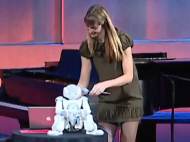 A group of developers from the Carnegie Mellon University (CMU) is working on an algorithm which enables robots to tell jokes. Although it still needs a lot of work on its comedy routine, the project enables development of more natural robot personalities that could be used in everyday human-robot interaction, help machines understand charisma and humor, and explore the applications and impact of having friendly robots in everyday lives.
A group of developers from the Carnegie Mellon University (CMU) is working on an algorithm which enables robots to tell jokes. Although it still needs a lot of work on its comedy routine, the project enables development of more natural robot personalities that could be used in everyday human-robot interaction, help machines understand charisma and humor, and explore the applications and impact of having friendly robots in everyday lives.
Robot in the wild is the name of the project lead by Heather Knight, who runs Marilyn Monrobot Labs in NYC and is a PhD student at the Carnegie Mellon’s Robotics Institute, in which developers hope that putting the robot “in-the-wild” also invites the general public to teach robots in natural and often playful social settings. The platform used in the project is Nao – humanoid robot developed by Aldebaran Robotics, which is widely used as a robotic platform in academic research today.
3. RoboEarth enables robots to share their knowledge over Internet
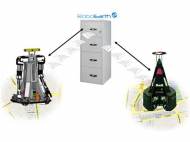 A group of about 35 people, part of the European project RoboEarth, is creating a worldwide, open-source platform that allows any robot with a network connection to generate, share, and reuse data. RoboEarth is developed in hope that it will greatly speed up robot learning and adaptation in complex tasks, as well as providing robots with possibility to execute tasks that were not explicitly planned for at design time.
A group of about 35 people, part of the European project RoboEarth, is creating a worldwide, open-source platform that allows any robot with a network connection to generate, share, and reuse data. RoboEarth is developed in hope that it will greatly speed up robot learning and adaptation in complex tasks, as well as providing robots with possibility to execute tasks that were not explicitly planned for at design time.
The folks from RoboEarth want to make the robot which is not able to fulfill a task to ask a person for help and store any newly learned knowledge. After the task has been successfully performed, the robot would share its acquired knowledge by uploading it to a Web-style database. Some time later the same task could be required, and a second robot that has no prior knowledge on how to execute the task could be designated to perform it. The second robot could query the database for relevant information and download the knowledge previously collected by other robots.
2. NEC PaPeRo robot used to provide activities information to elderly
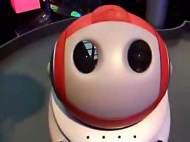 PaPeRo (Partner-type-Personal-Robot) – a personal robot from NEC Corporation – has been developed since 1997. It is being developed to interact with people and provide them with more information or entertain them. Due to increasing number of elderly people living alone, the folks from NEC conducted a research where they programmed PaPeRo to provide them with more information about local activities they could participate.
PaPeRo (Partner-type-Personal-Robot) – a personal robot from NEC Corporation – has been developed since 1997. It is being developed to interact with people and provide them with more information or entertain them. Due to increasing number of elderly people living alone, the folks from NEC conducted a research where they programmed PaPeRo to provide them with more information about local activities they could participate.
It is capable to walk around objects, measure the distance and approach people, follow people, remember people and differentiate them. PaPeRo speaks while facing the direction of a person by means of image recognition, and this method also helps to hear the person it is speaking with. A microphone is used for noise cancellation which enables PaPeRo to hear in noisy environment.
1. LG Hom-Bot – a smart vacuum cleaning robot
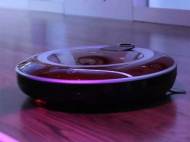 As a part of our mini-series where we wrote about robotic vacuum cleaners, we wrote about LG RoboKing’s successor named Hom-Bot Smart Vacuum Cleaning Robot. Hom-Bot Smart Vacuum Cleaning Robot was recognized as a finalist at the 7th Annual Invention and Entrepreneurship Award in Robotics and Automation (IERA). In addition to its technological achievement, Hom-Bot was named a winner of a red dot design award as well.
As a part of our mini-series where we wrote about robotic vacuum cleaners, we wrote about LG RoboKing’s successor named Hom-Bot Smart Vacuum Cleaning Robot. Hom-Bot Smart Vacuum Cleaning Robot was recognized as a finalist at the 7th Annual Invention and Entrepreneurship Award in Robotics and Automation (IERA). In addition to its technological achievement, Hom-Bot was named a winner of a red dot design award as well.
The robot is developed for the European market, and it’s much better than its predecessor, but the folks from LG haven’t learned from their previous mistakes in pricing.









Leave your response!